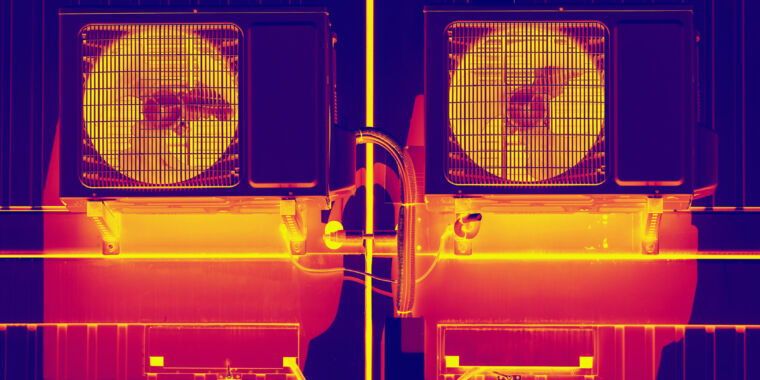Nine states are teaming up to accelerate adoption of this climate-friendly device.
Death is coming for the old-school gas furnace—and its killer is the humble heat pump. They’re already outselling gas furnaces in the US, and now a coalition of states has signed an agreement to supercharge the gas-to-electric transition by making it as cheap and easy as possible for their residents to switch.
Nine states have signed a memorandum of understanding that says that heat pumps should make up at least 65 percent of residential heating, air conditioning, and water-heating shipments by 2030. (“Shipments” here means systems manufactured, a proxy for how many are actually sold.) By 2040, these states—California, Colorado, Maine, Maryland, Massachusetts, New Jersey, New York, Oregon, and Rhode Island—are aiming for 90 percent of those shipments to be heat pumps.
“It’s a really strong signal from states that they’re committed to accelerating this transition to zero-emissions residential buildings,” says Emily Levin, senior policy adviser at the Northeast States for Coordinated Air Use Management (NESCAUM), an association of air-quality agencies that facilitated the agreement. The states will collaborate, for instance, in pursuing federal funding, developing standards for the rollout of heat pumps, and laying out an overarching plan “with priority actions to support widespread electrification of residential buildings.”



We got a new heat pump installed in our 1920s house in Minnesota a couple years ago. It works its ass off all year, and only needs help from the boiler in the deepest depths of winter, which it probably wouldn’t if the house were better insulated. It’s always cheaper for us than gas, and it feels great to have our climate control 80-90% decarbonized.
Yeah cold climates are the place where heat pumps will always struggle the most. I’m also from MN and have been eyeing this as an option once my 30yo furnace finally gives in.
These modern ones work so well even in adverse conditions that they’re gaining traction in MN with HVAC companies, which is very good to see.
What? There are tens of thousands of new alpine chalets that have a heat pump as their only source of heating and hot water
They’ll only struggle if you insulated your house with half a dozen feathers
We’re kinda saying the same thing. New heat pumps are improving on a problem that’s been around for decades.
https://yaleclimateconnections.org/2023/03/do-heat-pumps-work-in-cold-places-heres-what-you-need-to-know/
I’m in Jackson, Wyoming. We replaced the gas furnace with a Mitsubishi Hyper heat. The only time we need secondary heating is when the temperature goes below -20°f.
the only ‘problem’ is you have to keep the bone burner or some alternate source of heat (or power) for when the electricity goes out. which it does, occasionally, in the winter.
Isn’t that a problem with most forms of heat? Propane forced air furnace isn’t doing shit without electricity. Multizone boiler isn’t doing shit without power (I may be half wrong here). Outdoor wood burner isn’t doing shit without power. Your left with a wood/coal stove/fireplace, or wall propane burners scattered around. Wood furnace in the basement can get you by. But without electricity most forms of heat are screwed anyways aren’t they?
Mostly yes, but also a little bit of no. Most gas furnaces could be powered by a battery backup or even the cheapest of gas generators since the blower motors only use 120v at 400w. You’d need a massive battery or generator to use a heat pump.
But as my neighborhood doesn’t have gas, I don’t really have that choice
I’m not aware of anything that’s made to be used as a heat source that doesn’t need electricity to work properly. Gas furnaces have fans that circulate the air. Gas boilers have pumps that circulate the water. Even most fireplaces I’ve seen have a fan system for circulating air (and those that don’t are obviously just for ambiance and not meant to heat the room they’re in, much less the house). All require electricity.
Wood stoves often just have radiators or fans powered by heat differentials.
They’re more of a solution for small cabins than mcmansions, though
radiant heat. like masonry heaters.
https://solar.lowtechmagazine.com/2015/02/restoring-the-old-way-of-warming-heating-people-not-places/
If your electricity goes out, how are you moving that heat around the house?
when i was a kid we had a boiler and radiators. worked with no power.
later in a different house, we had fireplaces that could also keep that house warm enough (we never ‘froze’, and neither did pipes) without its fans going.
both were in rural areas where outages were much more common than the small town i’m in currently.
Thermoelectric fans! You can plop one on a stove and the heat directly generates electricity to turn the blades, pushing the air around.
Electric stove is typing…
I’ve got a pellet stove that can run for many hours off of a small portable battery backup.
Heat pump would be preferable, though.
We want to install one this year in our MN 1920s house. Our mini splits A/C died last year. So we need both an A/C and cheaper heat will be nice. Did you like who you used?
Yeah, we got a Daikin setup installed by MSP, who work in the Twin Cities metro.
I’ve seen them before. I am still looking at companies.